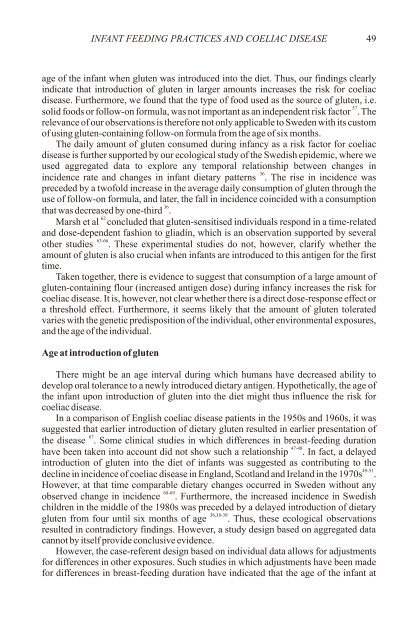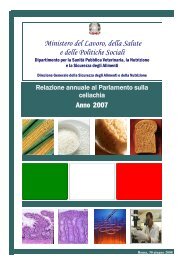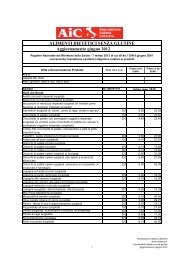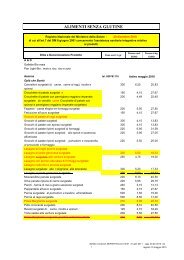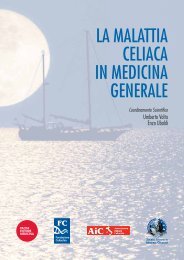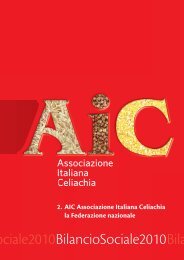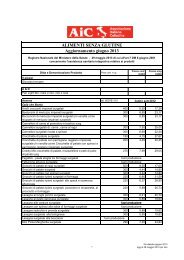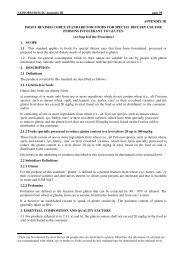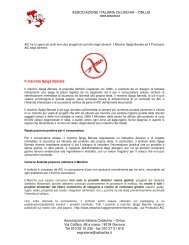primary prevention of coeliac disease - Associazione Italiana ...
primary prevention of coeliac disease - Associazione Italiana ...
primary prevention of coeliac disease - Associazione Italiana ...
Create successful ePaper yourself
Turn your PDF publications into a flip-book with our unique Google optimized e-Paper software.
INFANT FEEDING PRACTICES AND COELIAC DISEASE<br />
49<br />
age <strong>of</strong> the infant when gluten was introduced into the diet. Thus, our findings clearly<br />
indicate that introduction <strong>of</strong> gluten in larger amounts increases the risk for <strong>coeliac</strong><br />
<strong>disease</strong>. Furthermore, we found that the type <strong>of</strong> food used as the source <strong>of</strong> gluten, i.e.<br />
57<br />
solid foods or follow-on formula, was not important as an independent risk factor . The<br />
relevance <strong>of</strong> our observations is therefore not only applicable to Sweden with its custom<br />
<strong>of</strong> using gluten-containing follow-on formula from the age <strong>of</strong> six months.<br />
The daily amount <strong>of</strong> gluten consumed during infancy as a risk factor for <strong>coeliac</strong><br />
<strong>disease</strong> is further supported by our ecological study <strong>of</strong> the Swedish epidemic, where we<br />
used aggregated data to explore any temporal relationship between changes in<br />
36<br />
incidence rate and changes in infant dietary patterns . The rise in incidence was<br />
preceded by a tw<strong>of</strong>old increase in the average daily consumption <strong>of</strong> gluten through the<br />
use <strong>of</strong> follow-on formula, and later, the fall in incidence coincided with a consumption<br />
36<br />
that was decreased by one-third .<br />
62<br />
Marsh et al concluded that gluten-sensitised individuals respond in a time-related<br />
and dose-dependent fashion to gliadin, which is an observation supported by several<br />
63-66<br />
other studies . These experimental studies do not, however, clarify whether the<br />
amount <strong>of</strong> gluten is also crucial when infants are introduced to this antigen for the first<br />
time.<br />
Taken together, there is evidence to suggest that consumption <strong>of</strong> a large amount <strong>of</strong><br />
gluten-containing flour (increased antigen dose) during infancy increases the risk for<br />
<strong>coeliac</strong> <strong>disease</strong>. It is, however, not clear whether there is a direct dose-response effect or<br />
a threshold effect. Furthermore, it seems likely that the amount <strong>of</strong> gluten tolerated<br />
varies with the genetic predisposition <strong>of</strong> the individual, other environmental exposures,<br />
and the age <strong>of</strong> the individual.<br />
Age at introduction <strong>of</strong> gluten<br />
There might be an age interval during which humans have decreased ability to<br />
develop oral tolerance to a newly introduced dietary antigen. Hypothetically, the age <strong>of</strong><br />
the infant upon introduction <strong>of</strong> gluten into the diet might thus influence the risk for<br />
<strong>coeliac</strong> <strong>disease</strong>.<br />
In a comparison <strong>of</strong> English <strong>coeliac</strong> <strong>disease</strong> patients in the 1950s and 1960s, it was<br />
suggested that earlier introduction <strong>of</strong> dietary gluten resulted in earlier presentation <strong>of</strong><br />
67<br />
the <strong>disease</strong> . Some clinical studies in which differences in breast-feeding duration<br />
47-48<br />
have been taken into account did not show such a relationship . In fact, a delayed<br />
introduction <strong>of</strong> gluten into the diet <strong>of</strong> infants was suggested as contributing to the<br />
49-51<br />
decline in incidence <strong>of</strong> <strong>coeliac</strong> <strong>disease</strong> in England, Scotland and Ireland in the 1970s .<br />
However, at that time comparable dietary changes occurred in Sweden without any<br />
68-69<br />
observed change in incidence . Furthermore, the increased incidence in Swedish<br />
children in the middle <strong>of</strong> the 1980s was preceded by a delayed introduction <strong>of</strong> dietary<br />
36,38-39<br />
gluten from four until six months <strong>of</strong> age . Thus, these ecological observations<br />
resulted in contradictory findings. However, a study design based on aggregated data<br />
cannot by itself provide conclusive evidence.<br />
However, the case-referent design based on individual data allows for adjustments<br />
for differences in other exposures. Such studies in which adjustments have been made<br />
for differences in breast-feeding duration have indicated that the age <strong>of</strong> the infant at


